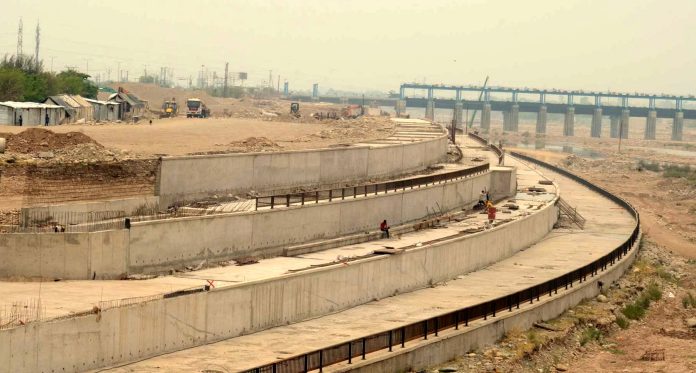Over 24,000 trees, shrubs to be planted in green spaces
*Artificial lake to recharge ground water aquifers
Mohinder Verma
JAMMU, Sept 7: Robust environment management plan is being followed in letter and spirit while executing Tawi River Front Development Project and more than 24,000 trees and shrubs will be planted in the open green spaces to further protect the environment. Moreover, artificial lake will go a long way in recharging the ground water aquifers.
This has been conveyed to the National Green Tribunal (NGT) by the Chief Executive Officer of Jammu Smart City Limited in response to the directions issued on May 22, 2024 in an Original Application wherein it has been claimed that large number of trees are likely to be axed while executing the Tawi River Front Development Project.
“On the left bank, an underpass is proposed to be constructed for providing seamless road connectivity to the riverfront and this will disturb the park from its existing location on the left bank. However, the loss of flora and fauna on account of its dislocation is more than adequately being compensated by creating green spaces elsewhere on the left bank, right bank and central island”, the Jammu Smart City Limited (JSCL) said.
Stating that there are 712 tress, plants, creepers of different species in the existing park of Tourism Department, the CEO said, “it will be an avowed endeavor of JSCL to relocate and replant these trees, plants and shrubs obtained from the existing park on the left bank to the new proposed location on the right bank”, adding “the total area of two chunks of park proposed to be developed on the right bank is 18 kanals as against an area of 17.39 kanals on the left bank and till date JSCL has not cut any tree on the left bank”.
“Besides relocating the existing park from the left bank to right bank including re-plantation of trees, shrubs and plants, a total of additional 1454 trees and 22885 shrubs will be planted in the proposed green open spaces on the left, right and central island. Moreover, promenades and green spaces will be provided with jogging tracks, cycling tracks, viewpoints, children play equipment etc”, the JSCL said, adding “the existing park from the left bank will be relocated to the right bank only after following due process as stipulated in the Jammu Municipal Corporation Act, 2000”.
With the completion of project, a lake will be created from Tawi Barrage up to Bikram Chowk Bridge in a length of one kilometer and besides adding to the aesthetics of the surrounding the same will also result into recharging of ground water aquifers in the vicinity of the project which will increase the ground water level ensuring replenishment of water table, the CEO has mentioned in the reply furnished to the NGT.
Stating that robust environment management plan is being followed in letter and spirit, the JSCL said, “all environmental concerns are thoroughly addressed. No mining or mineral excavation is involved during the construction phase. Dredging activities are undertaken to remove deposited material from the riverbed ensuring smooth river flow. Moreover, the dredged material is utilized within the project for embankment and other works”.
The JSCL further said, “the project has no negative impact on water quality. In fact, it is designed to improve the water quality by diverting all existing nullahs on both sides of the river through 1200 mm diameter interceptor drainage pipelines to the existing STPs on left bank and right bank”, adding “the project under execution has no built-up area as only open to sky promenades are being constructed”.
Disclosing that next stage of project may involve some developmental/construction activity in pockets of the reclaimed land, the JSCL said that all such activities will be taken up only after conducting Environment Impact Assessment and obtaining environment clearance from the concerned authorities as stipulated under Environmental (Protection) Rules, 1986 and notification of Ministry of Environment and Forests dated September 14, 2006.


